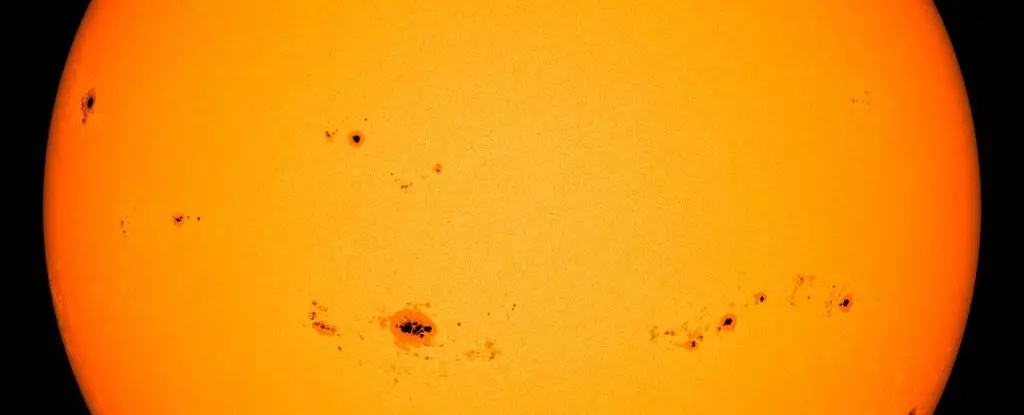The cosmos has a way of reminding us of its dynamic nature, and recent announcements from NASA, the National Oceanic and Atmospheric Administration (NOAA), and the Solar Cycle Prediction Panel signal a noteworthy uptick in solar activity. As we embark on the solar maximum phase of the Sun’s 11-year cycle, it’s critical to explore what this means for our planet and our technology, as well as delve into the mysterious processes that govern this stellar phenomenon.
Solar maximum marks a peak in the Sun’s cycle, characterized by an increase in sunspots, solar flares, and coronal mass ejections (CMEs). This heightened activity creates a veritable science fair of wonders and hazards alike that ripple through the solar system. Scientists are keenly observing the ramifications of this ongoing phase, where the Sun’s magnetic activity reaches frenetic levels, leading to not only more visual spectacles in our sky, such as magnificent auroras, but also potential threats to technology that we have come to rely upon.
At solar maximum, the behavior of our Sun can lead to widespread radio interference, compromised satellite operations, and even impacts on power grids due to geomagnetic storms ignited by CMEs colliding with Earth’s magnetic field. These forces of nature serve as a reminder of our technological vulnerabilities, underscoring the importance of monitoring solar cycles to mitigate risks.
Despite our advanced understanding of solar dynamics, predicting the specifics of solar maximum remains an elusive goal. Meteorologist Elsayed Talaat from NOAA noted that while we are currently in the maximum phase, determining when this activity will reach its zenith remains uncertain. Predictions made about solar cycles often fall short because the inner workings of the Sun—the solar dynamo that produces sunspots and associated phenomena—are not fully understood.
This unpredictability feeds into larger questions about solar behavior and its cyclic nature. Each solar cycle averages about 11 years, yet the duration and intensity can vary significantly from one cycle to the next. The curious question lingers: How do we better understand the fundamental mechanisms driving these cycles? According to Michael Wheatland, a solar astrophysicist, our grasp on the solar dynamo is still fraught with gaps in knowledge, marking an outstanding challenge in the field of astrophysics.
As solar maximum unfolds, the most visible manifestations of this heightened activity are sunspots, which can be likened to the freckles that mark a sun-kissed face. These regions on the Sun’s surface signify areas of intense magnetic activity, inhibiting the regular flow of plasma, leading to cooler, darker spots. As sunspots proliferate, so too do the eruptions of energy known as solar flares.
Solar flares have the potential to disrupt radio communications on Earth. On October 4, the Sun unleashed an X9.0 flare, ranking among the most powerful ever recorded. The potential threat to infrastructure cannot be understated; as coronal mass ejections hurl solar particles toward Earth, geomagnetic storms can wreak havoc on our power grids, transportation systems, and communication networks.
However, not all aspects of this solar activity are detrimental. The same ferocious energies that can pose threats also result in stunning shows of beauty in the form of auroras. As the charged solar particles from CMEs collide with Earth’s atmosphere, splendid displays of light illuminate the night sky, captivating those fortunate enough to witness them.
As solar activity continues, scientists are not just concerned with observing the immediate effects but also analyzing the broader implications for future solar cycle predictions. The current cycle has been stronger than initial forecasts suggested, prompting researchers to reevaluate their models for predicting solar behavior. Some experts have posited that a more robust understanding of the determinants that influence solar cycles could lead to improvements in forecasting solar activity.
While we may currently sit beneath the tumultuous effects of solar maximum, it is essential to remember that this is but one phase in a continued cycle. The workings of our Sun will remain a compelling area of exploration for scientists and astronomers alike. As we seek to understand both the unpredictability and the magnificence of our cosmic companion, humanity stands both in awe and in caution, aware of the power that resides within the fiery heart of our solar system.
So, as we look up at the sky and witness the effects of our Sun’s activity, let us appreciate the intricate dance of cosmic forces that continue to shape both our planet and our understanding of the universe at large. The journey ahead promises to be filled with scientific discovery and spectacular sights as we ride the waves of solar activity into the unknown.


Leave a Reply